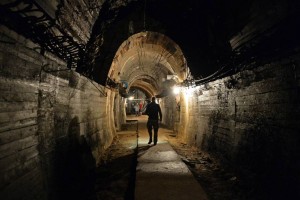WSJ Historically Speaking: Gold That Glitters—and Kills
Since ancient times, the desire for gold has had a way of turning human beings into monsters of greed. The Greek god Dionysus granted the mythical King Midas the golden touch, but only after the king had inadvertently turned his daughter into gold—and realized that he himself would starve to death—did he see his wish as a curse. The Roman poet Virgil wrote in “The Aeneid,” “Accursed thirst for gold! What dost thou not compel mortals to do?”
The alleged discovery last month in Poland of one of the lost Nazi “gold trains” is a case in point. Missing from the excitement over the train—supposedly dispatched at the end of the war (and buried since then), with millions of dollars worth of stolen loot, gold bars and armaments—is acknowledgment that this so-called treasure is the effluence of evil.
Prospectors have flooded the area where the train is said to be. Last week, regional authorities sought the help of the Polish army, as if to prove the famous line in John Huston’s 1948 film “The Treasure of the Sierra Madre”: “When the piles of gold begin to grow…that’s when the trouble starts.”
The ancient myths were full of warnings and examples of gold’s malevolent powers. Horror and shame lie at the crux of these stories, from the Greek tale of the Golden Fleece, whose capture eventually cost Jason his family, to the golden ring Andvaranaut of Norse mythology, which brought death to Sigurd (Siegfried in Richard Wagner’s Ring Cycle) and Brynhildr.
The 16th-century Spanish conquistadors either ignored or dismissed such warnings. Driven by an almost unparalleled lust for gold, the Spanish destroyed two indigenous empires, the Aztec and the Inca, as well as their ancient cultures, without ever finding what the Europeans considered the real prize: the city of El Dorado, allegedly built on inexhaustible reserves of gold. The city’s discoverer, it was thought, would be the richest man on Earth.
Ironically, the myth of El Dorado was based on a kernel of truth. It wasn’t a place but a person. High above the Andes in central Colombia, the Muisca peoples would initiate a new chief by showering him with gold dust, thus making him the “Gilded One.” He would then be rowed out to the center of Lake Guatavita while the crowd made offerings to the lake gods by throwing gold and jewels into the water.
The Spanish never realized that Lake Guatavita—which they freely plundered—was the origin of the El Dorado legend. As a result, hundreds of adventurers lost their lives searching for the city. Some left behind a bloody trail, like the conquistador Lope de Aguirre (circa 1510-1561) who went insane with paranoia and murdered most of his fellow explorers. Others squandered their lives and fortunes, like Sir Walter Raleigh (circa 1552-1618), the Elizabethan poet and philosopher who launched two futile expeditions to the New World. The second was a disaster and led to the killing of Raleigh’s son Wat in a skirmish with the Spanish.
Already out of favor with James I, Raleigh returned to England a broken man. His battle with the Spanish, which threatened the new peace between the two countries, played a major role in his execution for treason in 1618.
Two centuries later, Edgar Allan Poe wrote a dirge on the curse of madness that threatens such treasure seekers: “Over the Mountains of the Moon, down the Valley of the Shadow, ride, boldly ride…if you seek for El Dorado.”

